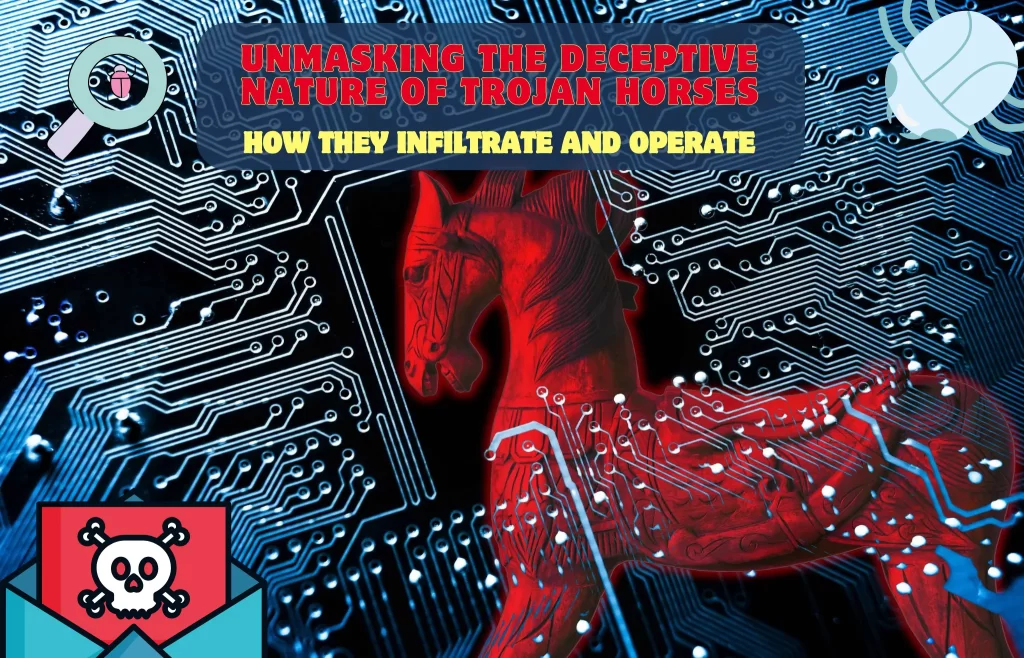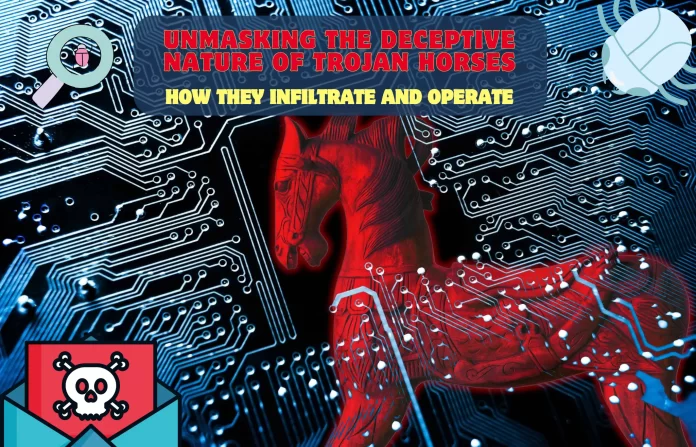
A Trojan horse, often referred to as a Trojan, is a type of malicious software or malware that disguises itself as a legitimate or benign program to gain access to a computer system or network. It derives its name from the famous wooden horse used by the Greeks to infiltrate the city of Troy during the Trojan War, as it hides its true intent behind a seemingly harmless exterior.
Trojan horses are typically distributed through deceptive means, such as email attachments, software downloads, or infected websites. Once they infiltrate a system, they can carry out a variety of harmful activities, including:
- Data Theft: Trojans can steal sensitive information such as usernames, passwords, credit card details, and personal files.
- Remote Access: Some Trojans allow attackers to gain remote access to the infected system, potentially giving them control over the victim’s computer.
- System Modification: Trojans can make unauthorized changes to a system’s settings or files, leading to instability or further security vulnerabilities.
- Keylogging: They can record keystrokes to capture login credentials and other confidential information.
- Distributed Denial of Service (DDoS) Attacks: Trojans can turn infected computers into part of a botnet to launch DDoS attacks on other systems or websites.
- Ransomware: Some Trojans act as a delivery mechanism for ransomware, encrypting a victim’s files and demanding a ransom for their decryption.
- Banking and Financial Fraud: Banking Trojans specifically target online banking and financial institutions to steal funds or perform fraudulent transactions.
The Evolving Landscape of Cybersecurity: Strategies for a Resilient Future
How Trojan Horse works:
- Disguise: Trojan horses are designed to mimic legitimate software or files, often using names and icons that appear harmless. They may masquerade as popular programs, documents, games, or even security software, making users more likely to interact with them.
- Delivery: Trojans are often distributed through various deceptive means, including email attachments, malicious websites, software downloads from unofficial sources, or even infected software updates.
- Execution: When a user unknowingly downloads and runs a Trojan, the malicious code within the Trojan is activated. This can happen when the user opens an infected email attachment, installs a bogus software update, or clicks on a link that leads to the Trojan.
- Payload: Trojans can carry out a wide range of malicious activities. The specific actions they perform depend on the Trojan’s design and the attacker’s intentions. Some common activities include:
- Data Theft: Trojans can collect sensitive information like login credentials, credit card details, or personal files. They may send this information to remote servers controlled by attackers.
- Backdoor Access: Certain Trojans create a backdoor, allowing attackers to gain unauthorized access to the infected system. This backdoor can be used for various purposes, such as remote control or further attacks.
- System Modification: Trojans can modify system settings or files, which can lead to system instability or introduce security vulnerabilities.
- Keylogging: Some Trojans record keystrokes to capture passwords and other sensitive information as the user types.
- Ransomware: Trojans can deliver ransomware to encrypt a user’s files, rendering them inaccessible until a ransom is paid.
- Botnet Participation: Some Trojans transform infected computers into part of a botnet, which can be controlled by a remote attacker for activities like Distributed Denial of Service (DDoS) attacks.
- Financial Fraud: Banking Trojans are a specialized type of Trojan that targets online banking and financial transactions. They attempt to steal login credentials and conduct fraudulent transactions.
How to Protect your self from Trojan
Protecting your computer and personal data against Trojans and other malware is essential. Here are several steps you can take to reduce the risk of infection and mitigate potential damage:
Nourishing Sleep: The Impact of Empty Stomach Sleep on Health and Wellness
- Install Antivirus and Anti-Malware Software:
- Use reputable antivirus and anti-malware software. Keep these programs updated to ensure they can detect the latest threats.
- Set up scheduled scans to regularly check your system for malware.
- Keep Your Operating System and Software Updated:
- Enable automatic updates for your operating system, web browsers, and other software applications. Software updates often include security patches to address vulnerabilities that malware can exploit.
- Use a Firewall:
- Enable a firewall on your computer. Firewalls help block unauthorized network traffic and can prevent certain types of malware from communicating with remote servers.
- Exercise Caution When Downloading and Browsing:
- Be careful when downloading files, clicking on links, or opening email attachments, especially if they are from unknown or suspicious sources.
- Avoid downloading software or files from unofficial or untrustworthy websites.
- Use Strong, Unique Passwords:
- Create strong and unique passwords for your online accounts. Password managers can help you generate and manage complex passwords.
- Enable multi-factor authentication (MFA) where possible to add an extra layer of security to your accounts.
- Secure Your Email:
- Be cautious with email attachments and links, as email is a common vector for malware distribution. Don’t open attachments or click on links from unknown sources.
- Use an email filtering system to help identify and quarantine suspicious emails.
- Enable Email Scanning:
- Configure your email client or webmail service to scan email attachments and links for malware.
- Regularly Back Up Your Data:
- Create regular backups of your important files and data. Use both local and cloud-based backup solutions.
- Test your backups to ensure they can be restored in case of data loss.
- Be Wary of Social Engineering:
- Trojans often rely on social engineering to trick users into running them. Be cautious of deceptive tactics such as fake alerts, misleading pop-ups, and persuasive messages.
- Disable Unnecessary Services and Features:
- Disable unnecessary or unused services and features on your computer. Reducing your attack surface can make it harder for Trojans to exploit vulnerabilities.
- Use a Standard User Account:
- Avoid using an administrator account for everyday tasks. Instead, use a standard or limited user account for routine activities. This limits the damage that malware can do if it infects your system.
- Educate Yourself and Stay Informed:
- Stay informed about the latest cybersecurity threats and best practices for online safety.
- Educate yourself and your family members about the dangers of malware and how to recognize potentially harmful online activities.
- Secure Your Network:
- Ensure your home network is properly secured with a strong, unique password. Regularly update your router’s firmware to patch security vulnerabilities.
Remember that while these measures can significantly reduce the risk of Trojan(Trojan Horse) infections, no system is completely immune to threats. Therefore, it’s essential to stay vigilant and practice good online hygiene to protect your digital assets and personal information.



